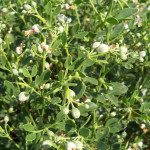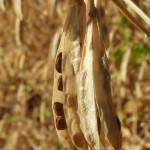Gallery:
- Zygophyllum fabago flowers and leaves
- Zygophyllum fabago seeds and seed pods
Common names:
Syrian bean-caper, bean caper
Scientific Name:
Zygophyllum fabago (syns. Zygophyllum fabago var. brachycarpum)
Description:
A bushy herbaceous perennial that may act like an annual in regions with harsh winters. Leaves somewhat succulent, opposite, compound and each having 2 ovals, 1 inch leaflets. Stems smooth and branched from a thickened woody crown. Flowers are small; compact bunches of five petals each with prominent stamens, salmon to yellow or white with pinkish veins and up to ¾ inch. Flower buds have been used as a substitute for capers. It reproduces by seed and vegetatively from lateral creeping roots.
Life cycle:
Height of mature plants
18 inches
Flower color:
White
Bloom time:
It flowers from May to August.
Look-a-likes:
None
Habitat:
Syrian bean-caper can be found in open, rocky areas and gravelly soils, including roadsides and disturbed areas.
Impacts:
Syrian bean-caper is well suited to dry environments. Buds and branches form on spreading roots, forming dense patches that compete for water and space. Large infestations can reduce forage potential in dryer areas of the west. It grows in masses, forming colonies, especially in dry, gravely, disturbed areas where other plant life is rare. Hand removal is often unsuccessful due to remaining root fragments that can generate new plants.
Noxious Weed Listing:
- WeedWise: Priority
- State of Oregon: Class A
- State of Washington: Class A
- Four County CWMA: Not listed
Origin:
Syrian bean-caper is native to the Middle East and central Asia.
Links:
Oregon Noxious Weed Pprofile
USDA Plants
Bugwood Wiki
Washington State Noxious Weed Control Board


